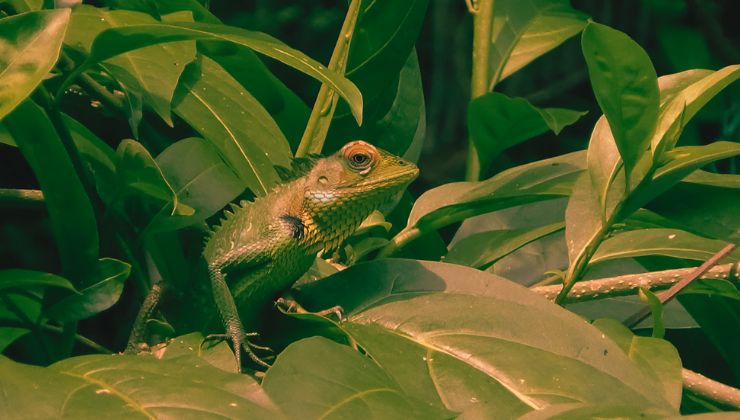
Chameleónovité
Among the most fascinating reptiles in the animal kingdom are members of the family Chameleónovité (commonly known as chameleons). These creatures have captured human curiosity for centuries due to their remarkable ability to change color, their independently moving eyes, and their specialized hunting techniques. Found mainly in Africa and Madagascar, but also across parts of Europe, Asia, and the Middle East, chameleons are living examples of evolutionary innovation. This essay explores the biology, behavior, adaptations, and conservation of these remarkable reptiles.
Taxonomy and Classification
Chameleónovité belongs to the order Squamata, which also includes lizards and snakes. Within this family, there are over 200 recognized species, spread across several genera such as Chamaeleo, Furcifer, Trioceros, Calumma, and Brookesia.
Taxonomists often classify chameleons based on physical traits such as body size, casque (helmet-like structures on the head), horns, and the presence of crests or ornamentation. Despite their diversity, all species share a common evolutionary ancestry, characterized by unique adaptations suited for arboreal life.
Geographic Distribution
The majority of chameleons are native to Madagascar, which is home to almost half of all known species. This island’s diverse ecosystems, from rainforests to dry spiny deserts, provide niches that support a wide variety of chameleons.
Outside Madagascar, chameleons are distributed across sub-Saharan Africa, with a few species reaching southern Europe, India, Sri Lanka, and the Arabian Peninsula. Their distribution highlights their adaptability, but most species still rely on specific habitats for survival.
Physical Characteristics
Chameleónovité species display striking diversity in size and appearance. Some are as small as Brookesia nana, which measures less than 3 cm in length, while giants like the Parson’s chameleon (Calumma parsonii) can grow up to 70 cm.
Key physical traits include:
-
Laterally compressed bodies, aiding camouflage among branches.
-
Prehensile tails, functioning almost like a fifth limb for gripping.
-
Zygodactylous feet, where toes are fused into two opposing groups for grasping branches.
-
Casques and horns, often used for display or competition among males.
These physical features not only define their identity but also reflect their ecological roles.
Unique Vision System
One of the most extraordinary traits of Chameleónovité is their eye structure. Each eye can move independently, giving them nearly 360-degree vision. This allows them to scan their surroundings for predators and prey simultaneously.
When a chameleon locks onto prey, the eyes coordinate, providing sharp depth perception. Their eyesight is so refined that they can detect small insects from several meters away. This combination of panoramic vision and precision targeting is unmatched in most reptiles.
Feeding Mechanism
Chameleons are insectivores, though larger species may consume small birds and reptiles. Their feeding strategy relies on their ballistic tongue, which can extend up to twice the length of their body.
The tongue tip has a sticky, suction-cup-like structure that ensures prey capture. The entire strike, from projection to retraction, occurs in fractions of a second. This adaptation is an energy-efficient hunting method, vital for species that spend most of their time motionless and hidden.
Color Change: Myth and Reality
The ability to change color is perhaps the most famous trait of Chameleónovité. Contrary to the popular myth, chameleons do not change color solely to match their background. Instead, color changes serve multiple purposes:
-
Communication: Bright colors signal dominance, readiness to mate, or territorial defense.
-
Thermoregulation: Darker shades absorb heat, while lighter colors reflect it.
-
Camouflage: Certain species use color shifts to blend into foliage.
This process occurs through specialized skin cells called chromatophores, which contain pigments, and iridophores, which reflect light. The interaction between these layers produces the dazzling spectrum of colors we associate with chameleons.
Behavior and Lifestyle Chameleónovité
Most Chameleónovité species are solitary and highly territorial. They prefer to live in trees and bushes, moving slowly and cautiously. When threatened, they may display bright warning colors, puff up their bodies, or hiss to ward off predators.
Activity patterns vary: many are diurnal, relying on daylight for hunting, while at night they often change to pale colors to reduce visibility. Their sedentary lifestyle conserves energy and helps them avoid detection.
Reproduction and Life Cycle
Chameleons typically exhibit oviparous reproduction, laying eggs that incubate in soil or leaf litter. Depending on the species, clutch sizes can range from a handful of eggs to more than 50. Some species, such as the Jackson’s chameleon (Trioceros jacksonii), are ovoviviparous, giving birth to live young.
Mating behaviors are often dramatic, with males displaying bright colors and engaging in physical contests using their horns or body postures. After mating, females may also become highly aggressive toward males, ensuring independence during egg development.
Ecological Role
As insectivores, chameleons play a crucial role in regulating insect populations, including agricultural pests. They, in turn, serve as prey for snakes, birds, and mammals. This makes them integral to the trophic balance of their ecosystems.
Their sensitivity to habitat conditions also makes them bioindicators. Declines in chameleon populations often signal broader environmental issues such as deforestation or climate change.
Human Interaction and Cultural Significance
Chameleónovité have fascinated humans since ancient times. They appear in African folklore as symbols of patience, adaptability, or mysticism. Their unique features have also inspired art, literature, and modern media.
In the pet trade, chameleons are highly sought after. However, their specialized needs, including precise temperature, humidity, and diet, make them difficult to keep in captivity. Irresponsible collection from the wild has contributed to population pressures in some regions.
Threats to Survival Chameleónovité
Chameleons face numerous threats in the modern world:
-
Habitat destruction: Logging, agriculture, and urban expansion reduce their natural environments.
-
Illegal pet trade: Many species are captured and exported despite protective laws.
-
Climate change: Altered rainfall and temperature patterns disrupt breeding and feeding cycles.
-
Predation and competition: Introduced species sometimes threaten local populations.
Due to these factors, several species are now listed as vulnerable or endangered by the International Union for Conservation of Nature (IUCN).
Conservation Efforts
To protect Chameleónovité, conservationists employ a range of strategies:
-
Protected areas: Establishing national parks and reserves, especially in Madagascar.
-
Captive breeding programs: Reducing pressure on wild populations by providing alternatives for the pet trade.
-
Legislation: Enforcing international agreements such as CITES (Convention on International Trade in Endangered Species).
-
Community education: Teaching local populations about the ecological importance of chameleons.
Effective conservation requires international cooperation, as many species are endemic and face region-specific threats.
Scientific Importance
Chameleons have long intrigued scientists studying evolution, physiology, and behavior. Their visual system has advanced our understanding of binocular vision. Research on their color-changing abilities contributes to materials science, inspiring developments in biomimetic technology such as adaptive camouflage and responsive textiles.
Furthermore, their ecological specialization provides insight into the processes of adaptive radiation, particularly in Madagascar, where chameleons have diversified into numerous niches.
Chameleons in Popular Imagination
Beyond science, chameleons symbolize adaptability and transformation in human culture. The phrase “being a chameleon” often describes someone who changes behavior or appearance to fit different situations. While this is a simplified metaphor, it reflects the universal fascination with their color-shifting abilities.
In films, advertisements, and literature, chameleons continue to serve as symbols of flexibility and mystery.
Conclusion Chameleónovité
The family Chameleónovité represents one of nature’s most remarkable evolutionary experiments. From their color-changing skin to their precision hunting techniques, these reptiles embody adaptability in its purest form. However, their survival is increasingly threatened by human activities and environmental change.
Protecting chameleons is not only about preserving unique reptiles but also about safeguarding the ecosystems they inhabit. By valuing Chameleónovité, we acknowledge the intricate connections within nature and the need for responsible coexistence.
In the end, chameleons remind us that true strength often lies in adaptability, patience, and balance with the environment.






